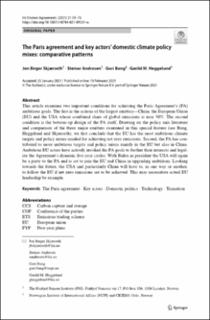| dc.contributor.author | Skjærseth, Jon Birger | |
| dc.contributor.author | Andresen, Steinar E | |
| dc.contributor.author | Bang, Guri | |
| dc.contributor.author | Heggelund, Gørild | |
| dc.date.accessioned | 2021-07-28T07:20:58Z | |
| dc.date.available | 2021-07-28T07:20:58Z | |
| dc.date.created | 2021-02-23T19:57:05Z | |
| dc.date.issued | 2021 | |
| dc.identifier.citation | International Environmental Agreements: Politics, Law and Economics. 2021, 21 (1), 1-15. | en_US |
| dc.identifier.issn | 1567-9764 | |
| dc.identifier.uri | https://hdl.handle.net/11250/2765443 | |
| dc.description.abstract | This article examines two important conditions for achieving the Paris Agreement’s (PA) ambitious goals. The first is the actions of the largest emitters ¬China, the European Union (EU) and the USA whose combined share of global emissions is near 50%. The second condition is the bottom–up design of the PA itself. Drawing on the policy mix literature and comparison of the three major emitters examined in this special feature (see Bang, Heggelund and Skjærseth), we first conclude that the EU has the most ambitious climate targets and policy mixes needed for achieving net zero emissions. Second, the PA has contributed to more ambitious targets and policy mixes mainly in the EU but also in China. Ambitious EU actors have actively invoked the PA goals to further their interests and legalize the Agreement’s dynamic five-year cycles. With Biden as president the USA will again be a party to the PA and is set to join the EU and China in upgrading ambitions. Looking towards the future, the USA and particularly China will have to, in one way or another, to follow the EU if net zero emissions are to be achieved. This may necessitate actual EU leadership by example. | |
| dc.language.iso | eng | en_US |
| dc.title | The Paris agreement and key actors’ domestic climate policy mixes: comparative patterns | en_US |
| dc.type | Peer reviewed | en_US |
| dc.type | Journal article | en_US |
| dc.description.version | publishedVersion | |
| dc.source.pagenumber | 1-15 | en_US |
| dc.source.volume | 21 | en_US |
| dc.source.journal | International Environmental Agreements: Politics, Law and Economics | en_US |
| dc.source.issue | 1 | en_US |
| dc.identifier.doi | 10.1007/s10784-021-09531-w | |
| dc.identifier.cristin | 1892933 | |
| dc.relation.project | Norges forskningsråd: 295704 | |
| dc.relation.project | Norges forskningsråd: 308789 | |
| dc.relation.project | Fridtjof Nansens institutt: 492 | |
| dc.relation.project | Norges forskningsråd: 280960 | |
| dc.relation.project | Fridtjof Nansens institutt: 481 | |
| dc.relation.project | Fridtjof Nansens institutt: 456 | |
| cristin.ispublished | true | |
| cristin.fulltext | original | |
| cristin.qualitycode | 1 | |
